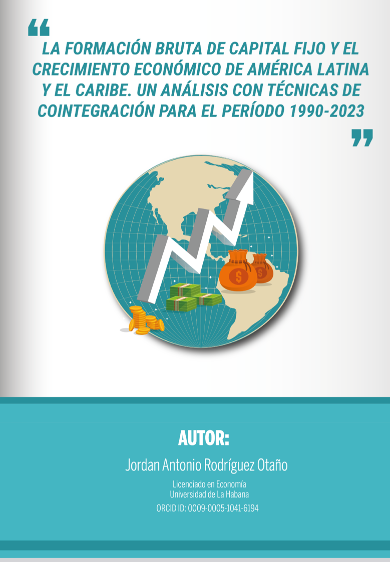The fixed capital formation and economic growth in Latin America and the Caribbean. An analysis with cointegration techniques for the period 1990-2023.
Keywords:
Economic growth; Fixed capital; Investment; Cointegration; Latin America and the Caribbean.Abstract
Macroeconomic growth models, especially orthodox neoclassical models, have always considered capital accumulation as the main source of growth for any country and, although it is true that modern endogenous growth theories consider other factors such as human capital, demographics and technology, just to mention a few, special importance is still given to fixed capital formation. In the case of Latin America and the Caribbean, it has been proven that investment in fixed capital is a necessary condition for economic growth in the region, but it is not enough to guarantee sustained growth in the long term. Structural changes are needed in the economies of the countries that make up the region, with the aim of promoting greater intra-regional cooperation and trade to facilitate technology transfer, as well as human capital formation and investment in R&D projects that increase marginal labor productivity and higher value-added exports.
Downloads
References
• Ariza, A. U. (2016). Formación bruta de capital fijo en el producto interno bruto venezolano en el periodo 1997- 2015. Revista Unisimon. https:// revistas.unisimon.edu.co/index.php/ desarrollogerencial/article/view/2 725/4586#toc
• Gujarati, D & Porter D. (2009). Econometría. Quinta edición. México: Mc Graw Hill.
• Eraso, J. K. (2013). Relación entre los modelos de series de tiempo univariadas con los modelos de series multivariadas. San Juan de Pasto.
• Granger, R. y. (1987). Co-integration and Error Correction: Representation, Estimation and Testing. Econométrica,
pp. 251-276.
• Instituto Nacional de Estadística de Bolivia (INE). (2023). Formación bruta de capital fijo. https://www.ine.gob.bo/ index.php/estadisticas-economicas/pib- y-cuentas-nacionales/formacion-bruta- de-capital-fijo
• Instituto Nacional para la Evaluación de la Educación (INEE). (2009). Producto Interno Bruto Per Cápita. https://www.inee. edu.mx/wp-content/uploads/2019/03/ CS07-2009.pdf
• Johansen, S. (1988). Statistical analysis of cointegration vectors. Journal of Economic Dynamics and Control, 231- 254.
• Ohlin, B. (1971). Comercio Intrerregional e Internacional. Barcelona: OIKOS-TAU.
• Pokorny, M. (1987). An Introduction to Econometrics. New York: Basil Blackwell.
• Ramírez, G. M. (2018). ¿Qué es lo primero: el crecimiento del PIB o la inversión? El caso de una economía pequeña y abierta. El Trimestre Económico, 115-136.
• Ríos, C. S. (2011). La economía del conocimiento como base del crecimiento. Revista Venezolana de Información, 43- 60.
• Solow, R. (1956). A contribution to the theory of economic growth. Quaterly Journal of Economics, 70: 65-94.
• Villavicencio, J. (2010). Introducción a series de tiempo. Puerto Rico.
• Wooldridge, J. M. (2010). Introducción a la econometría. Un enfoque moderno. 4ta edición. South-Western Cengage Learning.

Published
How to Cite
Issue
Section
License
Copyright (c) 2025 Revista Científica Universitaria Ad Hoc

This work is licensed under a Creative Commons Attribution-NonCommercial 4.0 International License.











